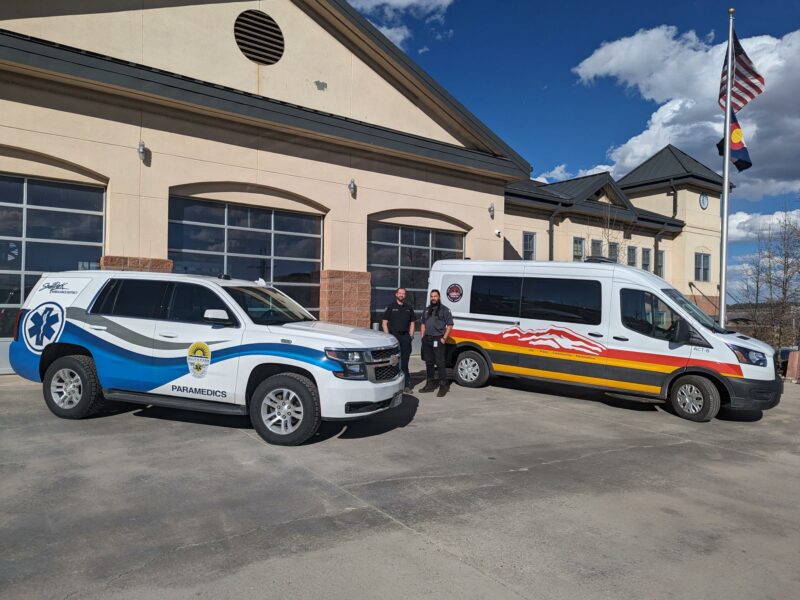FAQs
The District, located in Park County, provides 911 emergency medical services in conjunction with ambulance services within the boundaries of the District.
The District is a quasi-municipal corporation and political subdivision established under the laws of the State of Colorado Special District Act. The District was established by Court Order dated December 9, 1991, pursuant to Article 1 of Title 32 of the Colorado Revised Statutes 1973, as amended. The District also operates in accordance with the provisions of the Colorado Emergency Services Act, Section 25-3.5-101, et seq., C.R.S., as amended. The Board of Directors of the District is responsible for the operation of and policies with respect to the District, in accordance with statute and the Service Plan.
Special Districts in Colorado are local governments, i.e., political subdivisions of the state, which make up a third level of government in the United States. (The federal and state governments are the other two levels.) Local governments include counties, municipalities (cities and towns), school districts, and other types of government entities such as “authorities” and “special districts.”
Colorado law limits the types of services that county governments can provide to residents. Districts are created to fill the gaps that may exist in the services counties provide and the services the residents may desire.
As political subdivisions of the State of Colorado, special districts are required to submit a number of required filings to various state agencies throughout the year. These filings are primarily financial, but also include election results, lists of boards of directors, and others.
For additional information: Colorado Department of Local Affairs
SPAD receives funds generated by property tax and fees for service (see Billing page). The mill levy is 9.5 mills. The mill levy was raised with overwhelming support from the residents in a May 2018 special election.
For additional property tax information: Park County Assessor Website
Yes. In order to keep the property tax mill levy as low as possible all patients utilizing ambulance transport are billed for services provided in accordance with recognized standards. Also see the billing page for additional questions regarding our billing policy.
SPAD is located in Park County on the eastern slope of the Continental Divide of the Central Rockies. Ambulances respond from the Headquarters Station located in Fairplay. Fairplay is approximately 85 miles southwest of Denver, 85 miles northwest of Colorado Springs, and 23 miles south of Breckenridge. The District provides service in an area of almost 1,500 square miles at an average elevation of 9,000 feet above sea level. 60% of calls for service are within a 15 minute response time from the station. View District Map
SPAD provides three paramedic level staffed ambulances per shift. Minimum ambulance staffing is 1 paramedic and 1 EMT. Staffing has been provided by career (full-time & part-time paid) personnel since 1992. All employees work under the supervision of the Medical Director utilizing national standard treatment protocols. SPAD utilizes the Denver Metro EMS Protocols.
The Colorado Department of Public Health and Environment certifies entry level competency of emergency medical technicians (EMTs) for the State of Colorado. EMTs in Colorado can be certified at one of three different levels: EMT-Basic, EMT-Intermediate and EMT-Paramedic. Certification is based on successful completion of a recognized training course and an application process (including fingerprint-based criminal history records check) conducted by the EMT Certification Program.
EMTs are allowed to perform medical acts as delegated by a Medical Director. All EMTs providing patient care in Colorado are required to have a Medical Director who directs how and where an EMT may practice. Medical Directors are physicians regulated by the Colorado Board of Medical Examiners and the scope of practice for EMTs can be found in the Board of Medical Examiners Rule 500.
SPAD has a fleet of six 4 wheel drive, Type 1, ambulances. Four ambulances are licensed as Advanced Life Support (ALS) and two reserve ambulances are licensed as Basic Life Support (BLS) by Park County in compliance with state requirements. One of the BLS ambulances is designated for the transport of COVID-19 patients. The ambulances carry all equipment necessary to perform ALS treatments including 12-lead cardiac monitors, endotracheal intubation, medication administration, CPAP and other advanced medical interventions. Ambulances are equipped with VHF and 800 MHz radios as well as cellular phones. An established fleet replacement plan ensures that vehicles are replaced on a consistent basis. Crews utilize a computer based incident reporting system. The District has two BLS quick response units. A Mass Casualty Incident (MCI) trailer is equipped to provide treatment to 35 patients. The MCI trailer is available for response throughout the county and the region.
Patients are transported to the closest appropriate hospital utilizing established protocols and state mandated destination policies. There are no definitive care facilities within the county. In 2005 Summit Medical Center at Frisco, a Level 3 Trauma Center, opened. This is now the nearest hospital. Additionally, patients may be transported to Denver or Colorado Springs. Depending on the location of the incident patients may be transported to Woodland Park, Salida, and Canon City. Average time with a patient, during Front Range transports, is 110 minutes.
SPAD personnel utilize specific protocol-based criteria to determine when the patient’s condition requires helicopter transport. Weather permitting helicopter transport is routinely used for critical patients. The only Level 1 Trauma Centers are located in Denver. Helicopters are based in Denver, Colorado Springs, Summit County and Pueblo.
Immediately dial 911. Park County has Enhanced 911 (E911) capabilities. Your location will be provided to the center. Your 911 call will be answered by a trained communications specialist at the Park County Communications Center (PCCC). PCCC will immediately dispatch the necessary resources. The SPAD service area covers three fire protection districts. In addition to an ambulance the nearest fire district unit will also be dispatched to respond as part of a tiered response system. If the fire unit arrives first they will provide BLS interventions until the arrival of the of the ALS ambulance. The appropriate law enforcement agency may also be dispatched.
The paramedic-level ambulance crew will respond. We’ll conduct an interview to ask what’s going on – we check symptoms, vitals and review medical history and allergy information. From there we formulate a diagnosis and action plan involving treatment.
Paramedic level refers to a specific level of training, education, and certification within the field of emergency medical services (EMS). Paramedics are highly trained healthcare professionals who are capable of providing advanced medical care in pre-hospital settings and during transportation to medical facilities. Paramedics have a higher level of skill and knowledge compared to emergency medical technicians (EMTs) and other lower-level EMS providers.
When treating a patient, we always explain what we are doing and why we are doing it. Sometimes the best treatment plan is to seek ongoing care at the hospital, and we encourage the patient to be transported via ambulance.
Your Options
- A person who has decision-making capacity may refuse examination, treatment, and transport.
- We do not have legal authorization to force people to be transported to the hospital.
- Paramedics are the pre-hospital setting; they evaluate and provide a recommendation. It’s ultimately up to patient if they want to go to the hospital or not.
- It’s important to note that just because we transport a patient to the ER, it doesn’t mean they will be seen right away. The ER staff evaluates each situation based on the cases that are currently there.
- Approximately 2/3 of patients accept transport. The other 1/3 are a mix between refusals of care and no patient involved requests for service.
- There are several factors as to why a patient would refuse transport and each case is unique. Examples include:
- People are often confused about how they are to get home. We encourage them to ask friends and family for support.
- The financial burden is also a common reason people refuse transport. The average cost of transport for an uninsured patient is $2,400.
- We have the benefit of being a special district and we are funded through taxpayer dollars as well as fees for service. We work with patients experiencing financial hardships and our board and have the ability write off the cost of their entire transport if a financial hardship is found to be legitimate.
The time we remain on scene will vary depending on the situation. If the refusal is straightforward, we will be on scene for about 20 minutes.
If the refusal involves a medical complaint (i.e. difficulty breathing), it’s mandatory we call and speak to the attending physician to get the proper release.
We are so far away from definitive health care, so if we recommend ambulance transport, it’s for a valid reason.
- Fairplay / Alma (Central area): North-West Fire Protection District
- Jefferson / Como (North / NE area): Jefferson-Como Fire Protection District
- Hartsel (South / SE / SW area): Hartsel Fire Protection District
Information for each fire district is provided on our Links page.

If you or someone you know is in crisis, get confidential and immediate support, 24/7/365,
by calling Colorado Crisis Services. Toll Free: 1-844-493-(TALK) 8255
Newsroom



